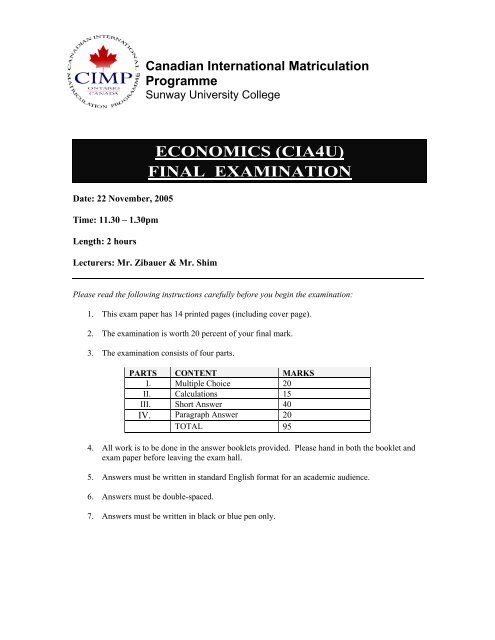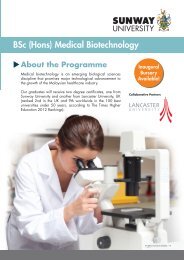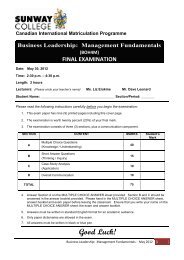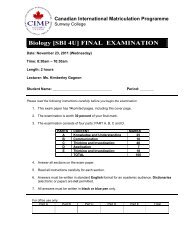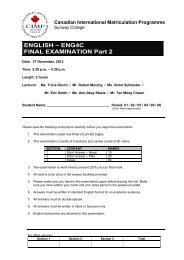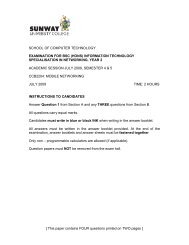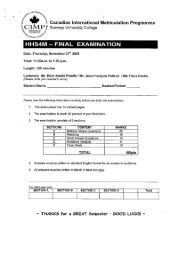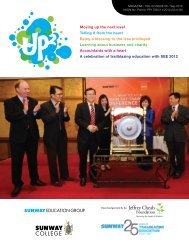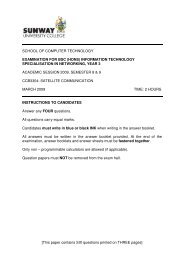Question Booklet
Question Booklet
Question Booklet
You also want an ePaper? Increase the reach of your titles
YUMPU automatically turns print PDFs into web optimized ePapers that Google loves.
Canadian International Matriculation<br />
Programme<br />
Sunway University College<br />
Date: 22 November, 2005<br />
Time: 11.30 – 1.30pm<br />
Length: 2 hours<br />
Lecturers: Mr. Zibauer & Mr. Shim<br />
ECONOMICS (CIA4U)<br />
FINAL EXAMINATION<br />
Please read the following instructions carefully before you begin the examination:<br />
1. This exam paper has 14 printed pages (including cover page).<br />
2. The examination is worth 20 percent of your final mark.<br />
3. The examination consists of four parts.<br />
PARTS CONTENT MARKS<br />
I. Multiple Choice 20<br />
II. Calculations 15<br />
III. Short Answer 40<br />
IV. Paragraph Answer 20<br />
TOTAL 95<br />
4. All work is to be done in the answer booklets provided. Please hand in both the booklet and<br />
exam paper before leaving the exam hall.<br />
5. Answers must be written in standard English format for an academic audience.<br />
6. Answers must be double-spaced.<br />
7. Answers must be written in black or blue pen only.
Final Exam November 2005<br />
Section I: Multiple Choice - 20 marks<br />
Select the best answer for the following multiple choice questions below. Then write the<br />
answer clearly on the line next to the answer. Make sure you mark it very clearly. Select<br />
the best answer.<br />
_____ 1. What statement below is the best definition of opportunity cost?<br />
a. The resources that are used to produce a particular good to satisfy one want<br />
instead of another.<br />
b. The cost of one good compared to that of another.<br />
c. The satisfaction we gain from choosing one good instead of another.<br />
d. The cost of all that is lost from choosing one good or action instead of another.<br />
_____ 2. Which of the following is the best example of a positive or analytical<br />
statement?<br />
a. The unemployment rate declined for two months in Indonesia by more than 0.5%.<br />
b. An unemployment rate of more than 7% should be acceptable to the government.<br />
c. A change in government will surely cause the unemployment rate to fall.<br />
d. A high unemployment rate is unacceptable to most people.<br />
_____ 3. In a command economy, who or what decides what will be produced?<br />
a. The people decide through their elected representatives.<br />
b. The managers of state enterprises and factories decide.<br />
c. The needs and wants of people “decide” what will be produced.<br />
d. The central planners decide based upon the priorities of the nation.<br />
_____ 4. What does Adam Smith’s theory of the “invisible hand” mean?<br />
a. In a competitive environment, business prosperity in the economy by pursuing<br />
profits for themselves.<br />
b. Government is the invisible hand, promoting economic welfare.<br />
c. Consumers are the invisible hand, directing production within the market<br />
economy.<br />
d. Monopolies impose and invisible hand, reducing competition between producers.
_____ 5. What was Karl Marx’s major criticism of capitalism?<br />
a. It would inevitably be overthrown by the working middle class.<br />
b. It led to the exploitation of workers by a minority of capitalists.<br />
c. It produced insufficient goods and services to provide a decent living for all.<br />
d. Governments would never try to improve working and living conditions for<br />
workers.<br />
_____ 6. Which of the following best defines supply?<br />
a. The cost of producing a good or service.<br />
b. The cost of producing a good or service at a particular price.<br />
c. The quantity a producer will supply at a given price.<br />
d. The quantity supplied is based on suppliers’ desire for profit.<br />
_____ 7. Arrange the order of the following market structure from most competitive to<br />
least competitive: (1) monopolistic competition; (2) oligopoly; (3) monopoly; (4) pure<br />
competition.<br />
a. 1,2,3,4<br />
b. 4,1,2,3<br />
c. 2,1,3,4<br />
d. 3,2,4,1<br />
_____ 8. Which of the following would most likely would be a fixed cost for a<br />
manufacturing business?<br />
a. Rent<br />
b. Wages<br />
c. Raw Materials<br />
d. Electricity<br />
____ 9. Which of the following would most likely be a variable cost for a manufacturing<br />
business?<br />
a. Property taxes<br />
b. Labour<br />
c. Rent<br />
d. Insurance<br />
_____ 10. Which of the following is a complete summary of expenditure-based GDP?<br />
a. C+I+G-X+M<br />
b. C+I-G+X+M<br />
c. C+I+G+X-M<br />
d. C-I+G+X-M
_____ 11. A sugar company sells sugar to a candy manufacture for $10 million: the<br />
candy manufacture sells can to a retailer for $15 million; and the retailer sells it to<br />
consumers for $20 million. What is the total value added to the GDP by these<br />
transactions?<br />
a. $20 million<br />
b. $30 million<br />
c. $40 million<br />
d. $45 million<br />
_____ 12. Leakages from the circular-flow model would include<br />
a. Government spending on goods and services.<br />
b. Capital goods spending by business firms.<br />
c. Decreases in the level of consumer spending.<br />
d. Increased purchases of foreign goods.<br />
_____ 13. Keynesian economic theory emphasizes that<br />
a. Market forces should be left to correct downturns in the economy.<br />
b. Supply creates its own demand.<br />
c. Governments must intervene with fiscal policies to stabilize the economy.<br />
d. Monetary policy should be relied upon to correct downturns in the economy.<br />
_____ 14. Which statement below best defines money?<br />
a. Anything that is generally accepted as a means of payment for goods and services.<br />
b. Anything of real value that people will accept in exchange for goods and services.<br />
c. A currency that is portable, durable, and divisible.<br />
d. Anything that the government can limit sufficiently so that it cannot be duplicated<br />
and used as a means of payment.<br />
_____ 15. What is meant by the term “welfare state”?<br />
a. Education and health social programs.<br />
b. A government that attempts to use programs to ensure health, education, and<br />
prosperity for all its citizens.<br />
c. A government that is constantly in debt.<br />
d. A state that attempts to ensure the happiness of all its citizens.<br />
_____ 16 A tax that is payable on tobacco, gasoline, and liquor is called<br />
a. an excise tax<br />
b. a proportional tax<br />
c. a property tax<br />
d. a sales tax
_____ 17. GDP falls and unemployment increases. Which type of unemployment will<br />
account for most of the increase?<br />
a. Seasonal<br />
b. Cyclical<br />
c. Structural<br />
d. Frictional<br />
_____ 18. If each country concentrated its production on what it produced best:<br />
a. World output would increase.<br />
b. World unemployment would rise.<br />
c. The result would be overspecialization by each nation.<br />
d. Only highly developed nations would benefit.<br />
_____ 19. In general, what is the effect of trade impediments such as tariffs upon an<br />
economy?<br />
a. They promote an efficient and competitive domestic industry.<br />
b. They lower prices and improve living standards.<br />
c. They raise a nation’s GDP.<br />
d. They benefits local producers, but at the expense of domestic consumer.<br />
_____ 20. One nation has an absolute advantage over another if…<br />
a. …it can produce a good or service with more resources than the other.<br />
b. …it is naturally wealthier than the other.<br />
c. …it can produce a good or service with less resources than the other.<br />
d. …it has greater resources than the other.
Section II: Calculations - 15 marks<br />
Based on the following data, answer the following questions using the data provided.<br />
You should have memorized each formula for the exam. Make sure you show your<br />
calculations and circle your answer clearly.<br />
1. Calculate the elasticity of demand (E d ) for the following data. (3 marks)<br />
Price (OLD) = $5.00<br />
Quantity (OLD) = 1500 units<br />
Price (NEW) = $7.50<br />
Quantity (NEW) 1250 units<br />
2. Calculate the Real GDP Growth Rate for the following data. (3 marks)<br />
Real GDP year 1 = $3,000,000<br />
Real GDP year 2 = $3,125,000
3. Calculate the unemployment rate for the following data. (3 marks)<br />
Number of unemployed = 40,000<br />
Labour force = 1,000,000<br />
4. Calculate the inflation rate for the following data. (3 marks)<br />
CPI year 1 = 104.00<br />
CPI year 2 = 114.00
5. Calculate the participation rate for the following data. (3 marks)<br />
Total labour force = 12,000,000<br />
Total employable population = 24,012,982
Section III: Short Answer <strong>Question</strong>s – 40 marks<br />
Answer the following short answer questions in full sentences. Make sure you use pen<br />
and write clearly.<br />
1 Explain what the law of diminishing returns means. Draw a graph to illustrate the<br />
law of diminishing returns. (5 marks)<br />
2. What are the three factors of production? Now, provide a real life example of each<br />
one. (5 marks)
3. What are the three forms of business organization. Give an example of each type of<br />
business organization. (5 marks)<br />
4. Explain the difference between deficit budget, surplus budget, and balanced budget. (5<br />
marks)
5. What are the three economic systems? (5 marks)<br />
6. Explain what a corporate alliance is. (5 marks)
7. What is a stock? What is a bond? What is a commodity? (5 marks)<br />
8. Draw the circular flow of income and then explain how the circular flow of income<br />
works. (5 marks)
Section IV: Paragraph Answers - 20 marks<br />
Based on the following questions, answer in the space provided in paragraph format.<br />
Marks will be deducted for not using paragraph format. Answer as clearly as possible.<br />
1. Comparing the ease to which a firm can enter or exit the market compare the different<br />
types of market structure. Draw a line illustrating the types of market structure and show<br />
from left to right how easy it is for a firm to enter or exit the market. Then give a real life<br />
example of each type of market structure. (10 marks)<br />
________________________________________________________________________<br />
________________________________________________________________________<br />
________________________________________________________________________<br />
________________________________________________________________________<br />
________________________________________________________________________<br />
________________________________________________________________________<br />
________________________________________________________________________<br />
________________________________________________________________________<br />
________________________________________________________________________<br />
________________________________________________________________________<br />
________________________________________________________________________<br />
________________________________________________________________________<br />
________________________________________________________________________<br />
________________________________________________________________________<br />
________________________________________________________________________<br />
________________________________________________________________________<br />
________________________________________________________________________
2. In a well-constructed paragraph, explain the theories and ideas of Karl Marx. Then,<br />
explain why his ideas have gone out of fashion in the latter part of the 20th Century. (10<br />
marks)<br />
________________________________________________________________________<br />
________________________________________________________________________<br />
________________________________________________________________________<br />
________________________________________________________________________<br />
________________________________________________________________________<br />
________________________________________________________________________<br />
________________________________________________________________________<br />
________________________________________________________________________<br />
________________________________________________________________________<br />
________________________________________________________________________<br />
________________________________________________________________________<br />
________________________________________________________________________<br />
________________________________________________________________________<br />
________________________________________________________________________<br />
________________________________________________________________________<br />
________________________________________________________________________<br />
________________________________________________________________________<br />
________________________________________________________________________<br />
________________________________________________________________________<br />
________________________________________________________________________<br />
Congratulations. You have finished Economics CIA4U. Pat yourself on the back.


